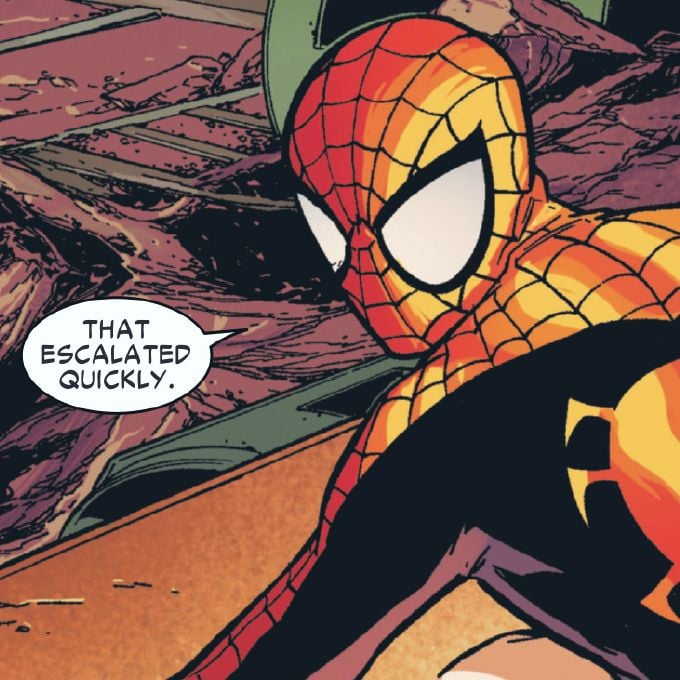We researched ourselves and found out that we are the best
I’d trust a group of employees doing this out of curiosity over, say, HR doing it.
deleted by creator
I imagine each employee crunched their own numbers using their own salaries and compared notes.
deleted by creator
What’s the efficiency in taking 30% of almost all game sales on a platform? I know we all love valve, but the efficiency here is having a store that everyone has to use if they want to make sales at all.
Valve’s 30% is high, sure. But you’re not seeing the total cost of selling a game.
And yes, I’ve done this before.
Besides the user count, besides all other factors. Digital sales are kinda hard.
You need to offer the actual game. If you’re selling an indie game that’s a few hundred megs, well you get to go sign up for a service to deliver it. Could be as simple as a google drive link, but because this is business use you get to pay business prices.
Are they charging a flat rate per month, per gig? Per download? Some combinations?
Now there’s updates and patches that need to be delivered. Same deal as before, but also now you need to handle the actual patching. Do you ship one big patch that checks for previous patches? Small individual patches that your users have to figure out what one they need?
Does your game have multiplayer? Well damn have fun with that.
What about support and refunds and GDPR stuff? Gotta factor all of that in too.
Now we get to do payment processing. You get to pay a company to accept payments on your behalf because you are NOT doing that yourself you WILL get stuck on inane and silly laws.
That’s part of it. Paying steam 3 bucks on my 10 dollar game to handle ALL of that? Yeah that’s fair. Could it be cheaper? Sure. a lot of things could. I don’t spend months on a game and then cheap out on the most important part: sales.
My time is valuable and worth 30%
Let’s not describe this as “paying valve three bucks” because that’s not accurate and is misleading.
It’s paying valve 30% of your revenue.
You’re better off never learning how little of what you pay your food actually goes to the producer, then…
Shockingly I’m also mad about that. I suppose you support that situation?
They didn’t frame it as “paying valve three bucks”. They said “paying valve 3 bucks on my 10 dollar game”. The phrase “paying pennies on the dollar” comes to mind as a common idiom for saying you’re paying a small fraction of the total, and neither literally means nor implies paying actual pennies.
Usually it does refer to paying less than 20% or so, yes. Not literal pennies, though.
It is misleading. It is 30% of the entire revenue of the game. And it is objective whether Valve deserves 30% of that revenue. It’s also true that games aren’t locked to the Steam platform and can absolutely make money outside of Valve’s influence. History has shown though that it is less profitable then being inside the Steam ecosystem.
Except that Steam allow their keys to be sold on other platforms and don’t take a cut on those. So it is 30% on the key sold on steam, but 0% on the other storefront.
So there is no reason to not go on steam because it doesn’t restrict you to steam.
Nobody is arguing that valve shouldn’t be compensated for the value they provide. Many of us do, however, argue they are taking too much. Their revenue per employee being so much higher than anyone else in the market supports that argument.
Uh huh, and I’m sure you’re privy to the exact financial breakdowns?
If someone could actually provide a better service than steam at a better price point, they would. The epic games store is shit, uplay is shit, origin is shit.
I agree with you, but its not an argument in Valve’s favor, that is unless you support monopolies. “They should take whatever they can, because no one else is competition.” Yeah, great. Capitalism at work. I agree that’s what they should do if we’re talking pure capitalist ideology, maximize profit at any cost. Is it the right thing to do though. They obviously (from the topic of this thread) make more than enough to pay every employee extremely well and then have a ton left over. They don’t need to charge 30% to get by.
RTFA, it is right there ffs
Not to mention Valve’s effort with Proton, allowing non-Windows gamers enjoy what they pay for on multiple platforms with great ease; their efforts have been massive for gaming on Linux, and without it, I wouldn’t have paid for a lot of games, earning their developers a whole lot of absolutely nothing.
Also the community hub, the workshop, the review system, the cloud saving, the functional wishlist, the gifting system, the shopping cart, the anti-cheat (you’re better of with it than without it), the discovery queue, the sales dedicated to specific types of games that actually help people discover games and drive the revenue up for the developers, the (I think) complete transaction history, the refunds system, the friends and the chat and profiles - and probably many more things that I’m either not aware of or couldn’t list off the tip of my tongue, combined with internal works that, again, do help the devs in the end.
Steam is much more than a place where one pays for a game to then simply download and play it. It’s much greater and more functional than that. None of the developers have to put their games on Steam - nobody forces Epic Games Store or GOG to be this subpar in comparison. Same way nobody forces gamers to use Steam. People use Steam because they love it - or because there’s no good-enough alternative, but that’s hardly Valve’s fault.
Steam charging 30% is not just worth it, but also surprising, given what putting your game on Steam gets you as the developer, and what it gets us, the players.
Not to mention Valve’s effort with Proton
And their VR efforts. VR seems to have lost popularity lately, but I was really glad that someone out there was competing with Palmer Luckey, especially once he sold out to Facebook.
And… holy shit, I just found out he’s Matt Gaetz’ brother in law. That explains a lot.
The efficiency is doing it so effectively that on an open platform competitors can create there own store, pay for AAA games to appear on their store, take the smallest of pay cuts, pass it on to the consumer, and still have customers prefer to pay more to be in the Steam ecosystem. I’m against monopolies but Valve’s is absolutely efficient.
That’s not how monopolistic marketplaces like Steam (and Amazon) operate, though. They have “Platform Most Favored Nation” (PMFN) clauses in their terms that mean products sold on the platform can’t be sold cheaper elsewhere…
Which means the whole “pass it on to the consumer” can’t happen, unless a product risks being de-listed from Steam. It literally removes the ability to compete on price.
You can find games sold cheaper than in Steam in many places. You can even buy games outside of Steam and they see 0 revenue from it.
Find me a game that has been de listed from Steam because it was sold cheaper elsewhere. You can’t, so don’t bother.
Find me a game that has been de listed from Steam because it was sold cheaper elsewhere. You can’t, so don’t bother.
I’m not going to dig through the web for an example of enforcement (which are not likely to be published anyway), when the only relevant matter is whether the PMFN clause exists. You can count every instance of a direct-from-publisher listing not being ~≤30% cheaper than the Steam listing as evidence that all you need is the threat of enforcement.
There is no reason in a market without this PMFN clause that a publisher wouldn’t sell the game at equal or higher margin off-Steam.
You can find games sold cheaper than in Steam in many places. You can even buy games outside of Steam and they see 0 revenue from it.
I would genuinely love if you could point me to an example where the non-discounted price of a game is lower outside of Steam than it is on Steam — I’d love to buy my games cheaper lol.
they see 0 revenue from it
This part confuses me. Are you trying to clarify to me that Steam isn’t taking a 30% cut of what gets sold on, say, Epic Games Store?
I would genuinely love if you could point me to an example where the non-discounted price of a game is lower outside of Steam than it is on Steam — I’d love to buy my games cheaper lol.
Fanatical and humble bundle (the good old days) are good examples. I don’t know what you say “non-discounted”, cheaper is cheaper no matter what.
This part confuses me. Are you trying to clarify to me that Steam isn’t taking a 30% cut of what gets sold on, say, Epic Games Store?
Steam doesn’t get a cut from keys sold in perfectly legal thirth party stores like fanatical, humble or gmg. Epic does not sell steam keys so obviously no.
Fanatical and humble bundle (the good old days) are good examples.
Incidentally Wolfire Games—the studio that founded Humble (but no longer operates it)—is currently in class-action litigation against Valve for this very issue.
I don’t know what you say “non-discounted”, cheaper is cheaper no matter what.
The Steam Distribution Agreement AFAIK allows temporary sales on other platforms to undercut Steam, but requires the “resting” price matches that on Steam. By specifying “non-discounted” I meant to indicate that although sales do exist on other platforms, the normal price of an item always matches on Steam. A quick few spot checks show the non-sale price of games on Humble, Steam, and Fanatical are equal.
“Cheaper is cheaper” kind of overlooks the core issue. Ultimately a publisher on Epic Games Store—which has a fee of 12% instead of Steam’s 30%—can have a lower price for a game as part of a promotion, but can’t just sell every game 18% cheaper always without violating Steam’s terms and being risk being de-listed.
Steam doesn’t get a cut from keys sold in perfectly legal thirth party stores like fanatical, humble or gmg. Epic does not sell steam keys so obviously no.
Okay, gotcha. Yeah, I misunderstood. For Steam Keys it’s pretty clear that Valve should be able to control the price since they provide the services after that key is purchased.
But the PMFN applies to all copies, even those distributed outside of Steam (e.g. the direct-from-publisher option I mentioned). Last time I was in a thread on this, another user found the following in the complaint (page 55) from the Wolfire v. Valve case mentioned above:
- TomG also explained to another game publisher that the publisher should “[t]hink critically about how your decisions might affect Steam customers, and Valve. If the offer you’re making fundamentally disadvantages someone who bought your game on Steam, it’s probably not a great thing for us or our customers (even if you don’t find a specific rule describing precisely that scenario).” In that same thread, TomG responded to a question by stating: “we usually choose not to sell games if they’re being sold on our store at a price notably higher than other stores. That is, we’d want to get that lower base price as well, or not sell the game at all."
- In response to one inquiry from a game publisher, in another example, Valve explained: “We basically see any selling of the game on PC, Steam key or not, as a part of the same shared PC market- so even if you weren’t using Steam keys, we’d just choose to stop selling a game if it was always running discounts of 75% off on one store but 50% off on ours. . . .”
“Cheaper is cheaper” kind of overlooks the core issue
You said this:
I’d love to buy my games cheaper lol.
I don’t know why you need them to be cheaper before the discount, but okay, I don’t care.
To add an example:
Take Cities: Skylines II. It’s listed at $50 on Steam, $50 direct from Paradox. If Steam is taking 30% cut, Paradox sees $35 from each sale. Why is Paradox not listing the game at $40? They would earn an extra $5 per sale, and draw more sales.
They have every economic reason to undercut Steam, but they aren’t. Like seriously, if not the PMFN, then what’s the explanation?
I guess I’m confused. Are you contesting that the PFMN clause has an effect or not? Whether that effect is anticompetitive?
Steam does more to promote and support games than many other platforms out there. Epic does not have workshop and forum, Google Play does not promote games as good as Steam.
Google Play
does not promote games as good as Steamhas ads.
Man, Epic must be patting themselves on the back for all the money they paid getting people to believe 30% was outrageous, because it’s paying massive dividends.
It may shock you to know that before Steam, your options were to fuck off or offer your product in a store where you would only get 30% of the profit, with the rest going to the publisher, the retailer, licensing, etc. These days it’s closer to 50% for physical copies, and Apple/Nintendo/Sony/etc all standardized with Steam on you getting 70% for digital.
Don’t like it? Pull a Valve and make your own alternative that’s better. If you build it, they will come… which is why nobody uses EGS.
I don’t believe if you build it they will come anymore. People are fucking lazy and will put up with whatever the fuck is happening with Twitter for convenience.
they say on the platform that exploded because Reddit decided to Spez.
I’m here, but none of my friends are here or on mastodon.
EGS has become free games store.
EGS is like walking around a grocery store offering free samples and leaving without buying anything.
Sort of. Except all the shelves have weird lips on them to keep you from grabbing the product easily, you kinda have to wrangle each item. Also it’s layout and design is archaic and super hard to navigate. And on every aisle there’s these little 3 inch steps that you have to go up and down and constantly trip on, or your cart gets stuck on them and you have to lift it up or drop it down. And then if you do manage to buy things, their support is terrible; at the other store if you need help cooking they have a 24 hour recipe hotline to help you out, but this one promises the same, but you actually wind up on hold for hours half the times you call.
So they got tons of free samples, but all their products are kinda a nightmare.
30% is more or less the standard. Not just in the games industry, but everywhere.
Epic is 12%. Yeah, Epic store sucks and all that. Whatever. There’s two marketplaces that aren’t first party. One takes 30% and one takes 12%. How is there a standard? You can’t look to other markets or other distribution methods to compare it to, because they’re all different with their own things.
Edit: GOG is 30% for indie developers (there’s a little more to it than that, but basically that). It sounds like with other publishers/developers they negotiate contracts on a case-by-case basis and don’t say what they get.
It’s actually not the standard, the standard was iirc 70% for in-store at the time. These days I think it’s closer to 50%, assuming no 3rd party losses/licensing.
Nintendo/Sony/Apple/etc are all 30% too, by the way.
deleted by creator
Did you know that almost every other marketplace out there (except that fucked up one) has the same 30% revenue split?
The whole debacle over it is artificial. It won’t change much if it looked better to people who complain now. It won’t remove Valve’s ability to provide the best service.









